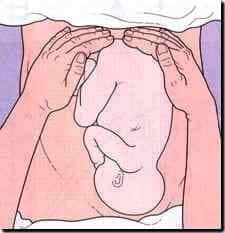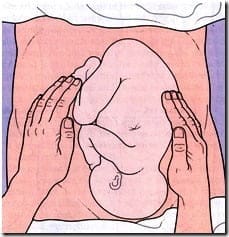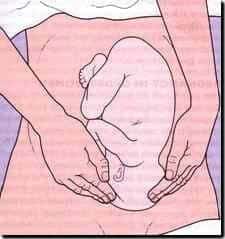Leopold Examination is a technique for examining pregnant women using palpation, which involves feeling and touching the parts of the pregnant uterus with hands in specific positions, or applying pressure to move specific parts to determine certain aspects.
Table of Contents
The theory is based on Christian Gerhard Leopold. This examination is best performed after 24 weeks of pregnancy, when all parts of the fetus can be felt. The primary purpose of the Leopold examination is to determine the position of the fetus in the uterus, but it can also be used to estimate the gestational age of the mother and predict/determine the weight of the fetus.
Leopold Examination may be challenging to perform on obese pregnant women with thick abdominal walls. It can also be uncomfortable for pregnant women if the position is incorrect, inadequate, or not done in a relaxed state.
To facilitate this examination, the following preparations are necessary:
- Instruct the client to empty their bladder.
- Position the client in a supine lying position and place a small pillow under their head for comfort.
- Maintain the client’s privacy.
- Explain the process and procedure of the examination.
- Warm the client’s hands by rubbing them together (cold hands can stimulate uterine contractions).
- Use the palms of the hands for palpation, rather than the fingers.
LEOPOLD I:

Objective: To determine the gestational age and identify the body part located in the fundus of the uterus.
Procedure:
- Bend the client’s knees and flex the thighs.
- Stand on the right side of the pregnant woman and look towards the client’s face.
- Bring the uterus to the center.
- Measure the height of the fundus uterus from where it meets the pubic symphysis (hard part).
LEOPOLD II:

Objective: To determine the position of the baby’s back and locate the smaller parts.
Procedure:
- Palpate the left and right sides of the uterus.
- If small and elongated parts are felt, it determines the limbs and fingers.
- If a broad and firm part is felt, it is usually in the lower left quadrant of the abdomen.
LEOPOLD III:

Objective: To determine the contents of the lower part of the uterus and whether the lower part is engaged in the pelvis.
Procedure:
- The right hand holds the lower part.
- The left hand attempts to press the fundus.
- Check if the lower part of the uterus can still be shaken or not.
- If it has not converged, Leopold IV is not necessary.
LEOPOLD IV:

Objective: To determine the lower part of the uterus and the extent to which it has descended into the pelvis.
Procedure:
- Convergent hand: Only a small part of the head descends into the pelvis.
- Parallel hands II: Half of the head enters the pelvis.
- Divergent hands: The largest part of the head enters the pelvis.
TO LISTEN TO THE FETAL HEARTBEAT:
- Locate the point of maximum intensity.
- Once clear, listen with a stethoscope or Doppler device.
- Compare with the mother’s pulse.
- Count the fetal heart rate per minute.
Normal range: >120-160 beats per minute.
If <120 or >160 beats per minute, it indicates fetal distress.
The Leopold examination is highly useful for obstetricians or midwives practicing in healthcare facilities without ultrasonography (USG) or cardiotocography (CTG) equipment. You can trust the accuracy of this manual method, as research has shown that the Leopold examination is comparable to the more expensive USG equipment.



